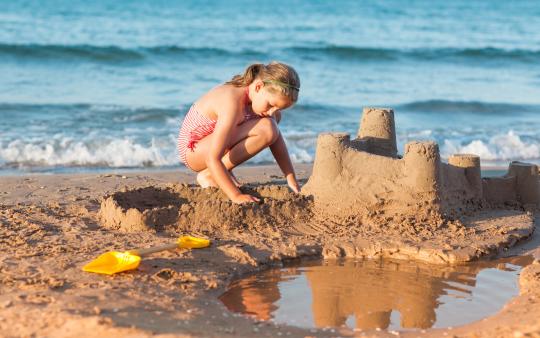During the hot, humid days of summer, there are few better ways to spend quality time with your family than relaxing and having fun at the beach. Our lakes and oceans offer endless recreation opportunities and give us a chance to spend time outdoors. But, how do you know if a beach is a safe, swimmable, and sustainable, place for your family to enjoy? We'll tell you how!

Photo credit: Environmental Defence Canada
Blue Flag can help you find out which beaches are the best of the best. The coveted international eco-certification for beaches, marinas, and tourism boats currently flies at over 4,000 locations in 44 countries around the world, including Canada. Blue Flags are awarded on an annual basis based on strict international criteria in four categories: water quality, safety and services, environmental management, and environmental education. The program is coordinated internationally by the Foundation for Environmental Education, and in Canada, is operated by Environmental Defence Canada.
What makes Blue Flag beaches a cut above the rest?
Water quality
No beach trip is complete without a dip in the water. And when you see a Blue Flag flying, you can feel confident that the beach is a great place for you and your kids to go swimming. Blue Flag beaches have their water tested on a frequent basis and are required to meet both international and local/national bathing water quality standards for 80 percent of the swimming season. Visitors can also find the latest water quality test results right at the beach.

Photo credit: Environmental Defence Canada
Safety and services
Beach safety is also a key part of Blue Flag. All Blue Flag beaches are required to have either lifeguards or public safety equipment in place to ensure the safety of visitors in, and near, the water. There are also first aid kits and emergency telephones available in the case of an incident. The Blue Flag program works with waterfront safety experts from across the globe to ensure beaches in the program are working to meet the highest standards for safe and swimmable water.
Even more, you can expect to find excellent facilities and services at Blue Flag beaches. To fly a Blue Flag, the beach must have clean and easily accessible washrooms. (Anyone who’s ever brought a baby or a toddler to the beach knows just how crucial this is!) Beaches also strive to have other accessible facilities, such as specialized mats for the beach to make them navigable by wheelchair, mobility device, or stroller. Many Blue Flag beaches have water wheelchairs available to borrow, so that everyone can enjoy a refreshing dip in the ocean or lake.

Photo credit: Environmental Defence Canada
Environmental management
It can be easy to think of the beach as just a place to play volleyball and catch some rays. However, it's important to remember that it's also a home for many different species of plants and wildlife. Because of this, Blue Flag beaches take extreme care to protect naturally sensitive areas and habitats. Many have healthy and thriving dune systems or wetlands nearby, and are homes to threatened or endangered species. Recently, Wasaga Beach and Outlet Beach, two Blue Flag beaches in Ontario, Canada, have had the endangered Piping Plover nest on their shores. These beaches are not only two of the most beautiful freshwater beaches in North America, but are also now sanctuaries for these rare birds that have slowly returned to the region in the past 10 years.

Photo credit: Environmental Defence Canada
Environmental education and information
Additionally, Blue Flag beaches help educate the public about what they can do to help protect the shoreline through various environmental education activities. For example, Grand Beach Provincial Park in Manitoba, Canada, hosts a guided walk called “Wetland Wildlife”. During the tour, a trained interpreter guides visitors through critical wetland habitat, explaining ecological features along the way.
Some of these activities also allow the public to roll up their sleeves and participate in hands-on initiatives to help keep the shoreline clean. In 2017, Blue Flag Canada held two beach cleanup events where volunteers collected plastic pollution and litter from the beaches. The volunteers collected data that was added to the International Shoreline Cleanup database where cleanup efforts are tracked worldwide. This is a great way for beach-goers to directly participate in the stewardship of their favorite beach.
If you can’t make it to an event or activity, there are still many opportunities to learn about the ecological features of a Blue Flag beach. In addition to having environmental activities and events throughout the summer, many Blue Flag beaches have information and interpretive signage about the flora and fauna that can be found in the area.
How can a beach get a Blue Flag?
So, with all the features that Blue Flag beaches have, you may be thinking: Wow! It takes a lot to fly that flag! And you’d be right.
Blue Flag beaches need to meet 33 criteria in order to be awarded the prestigious eco-certification. They also need to apply for the flag on an annual basis, and their applications are reviewed by both a national and an international jury. Once awarded in the spring, the beaches raise the flags and fly them proudly. During the summer, the beach also gets audited to make sure it’s continuing to live up to Blue Flag standards.
Every year, you only have so many days to enjoy the summer sunshine with your family, so why not make sure you’re going to have a great experience at a place that strives to maintain important standards? When you see a Blue Flag flying, there’s no doubt that you are at a world-class beach.

Photo credit: Environmental Defence Canada
If there is a beach in your neighborhood or community that you would like to see fly the Blue Flag, visit BlueFlag.ca if you live in Canada, or BlueFlag.Global for more information.






